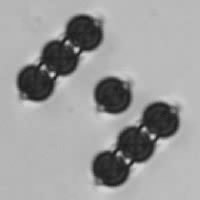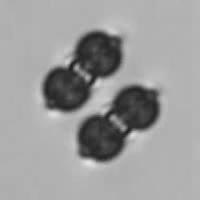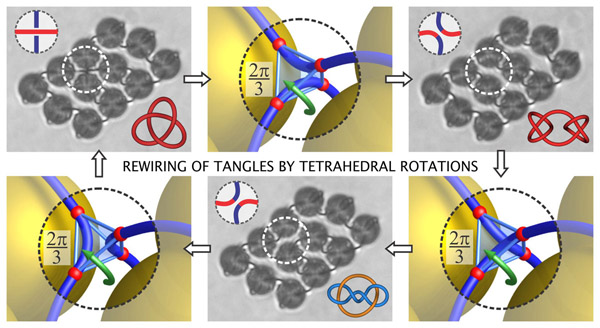Knots and links in chiral nematic colloids
Knots are fascinating topological objects that have been plaguing human minds down the ages. We show that immersed surface-treated colloidal particles in a nematic liquid crystal induce topological defect loops that can be merged into knots and links of arbitrary comlexity. By choosing different arrays of colloidal particles that could be manipulated using laser tweezers, structures where neighboring defect loops cross each other were generated allowing the demonstration of all knots and links with up to six crossings, including the Hopf link, the Star of David, and the Borromean rings.
An individual colloidal particle in the twisted nematic cell acquires a single defect loop, which is equivalent to the unknot. We used laser tweezers to bring together several particles and observed either spontaneous or laser-assisted fusion of their rings, leading to the formation of longer loops that entangle two or more particles. In such small colloidal clusters, all the loop conformations are likewise topologically equivalent to unknotted ring. |
|
|
|
When the colloidal clusters are expanded to arrays of pxq particles, the true richness of knots and links is revealed. A series of nematic braids, realized on 3xq particle arrays demonstrates the basic torus links and knots. |
|
|
|
To identify the topology of the entangled loops, we performed a sequence of topology-preserving Reidemeister moves, which virtually transform the real physical conformation of the loops into its minimal knot diagram. The defect lines are schematically redrawn to show the relaxation mapping. |
|
|
|
The knots and links can also be reversibly retied. This corresponds to locally changing the mutual contact – the unit tangle – between the two segments of the knotted line, which can either cross or bypass one another in two perpendicular directions. The laser-assisted retying of knots and links can be performed for any desired knotting sequence of unit tangles at any specific position in a colloidal array. Interestingly, each tangle can be enclosed in a tetrahedron and the rewiring of the tangles corresponds to a solid rotation of the director field inside tetrahedron. |
|
|
|
Having experimental control over the knotting and mathematical tools for finding all possible conformations of nematic braids, we were able to perform a made-to-order assembly of knots and links. We selected Borromean rings as an example of a complex interwoven structure and specified the size of particle array to be 4x4, the smallest one for the chosen link. By using a computer algorithm that is based on calculating the polynomial invariants from knot theory, the corresponding tangle configuration was identified. Lastly, the Borromean rings were experimentally assembled using laser tweezers. |
|
|
|
We have shown that chiral nematic colloids are stabilized by defect knots and links of fascinating complexity, which can be fully controlled and rewired by light. We believe that the strategy presented here could offer a guidance to further progress in knotting of topologically nontrivial entities, such as DNA, skyrmion lattices in chiral magnets and confined blue phases, and entangled vortices in superconductors. |
TKALEC, Uroš, RAVNIK, Miha, ČOPAR, Simon, ŽUMER, Slobodan, MUŠEVIČ, Igor. Reconfigurable knots and links in chiral nematic colloids. Science, 2011, vol. 333, 62-65.
Highlighted as Perspective by Randall Kamien, Knot Your Simple Defect Lines?, Science 333, 46 (2011). |
|
Links to other highlights:
New Scientist Nature Materials Max Planck Society Soft Matter Blog Science News Photonics.com Nano News Net Wetenschap 24 Kvarkadabra Mladina Ministry of higher education, science and technology |









